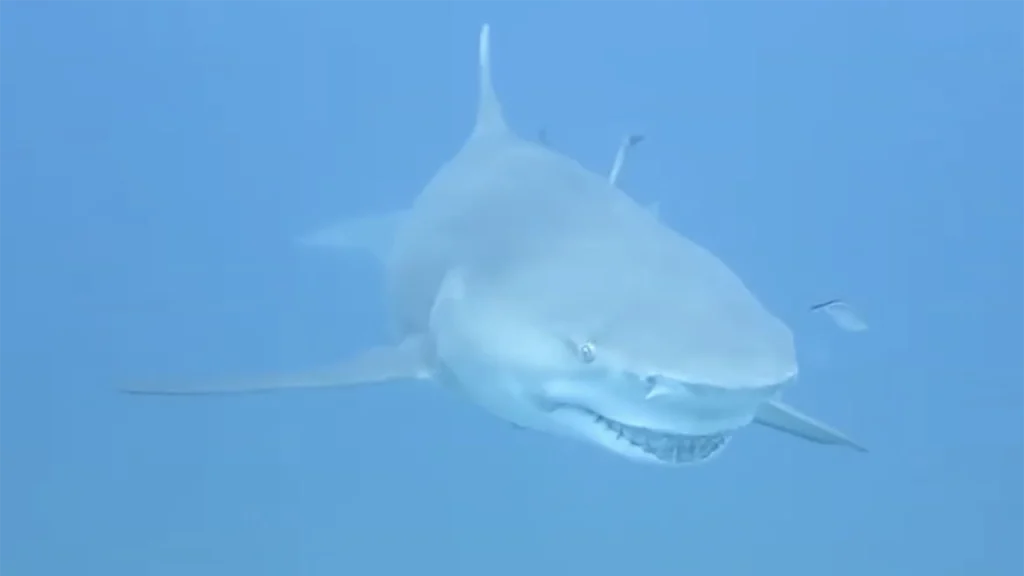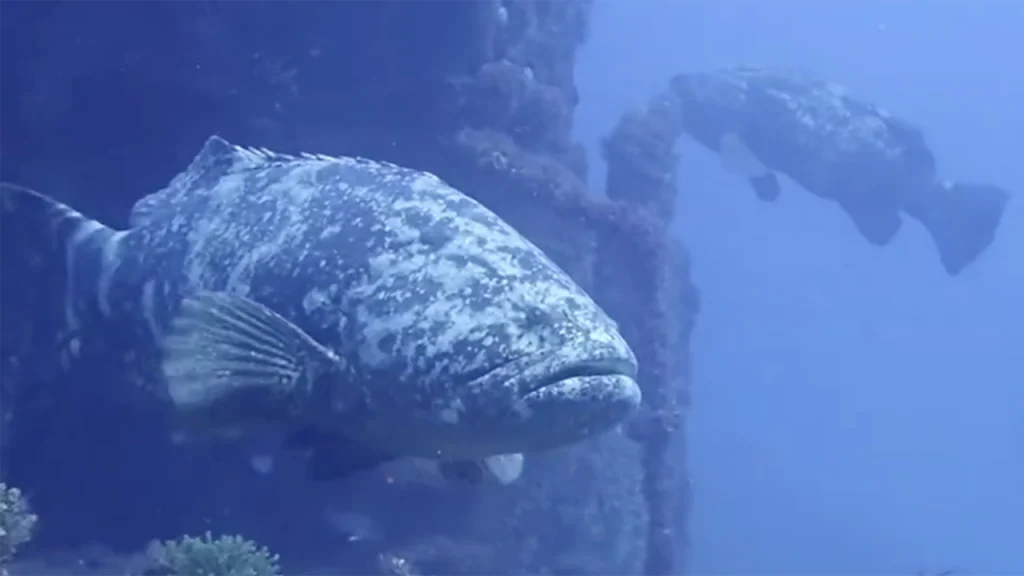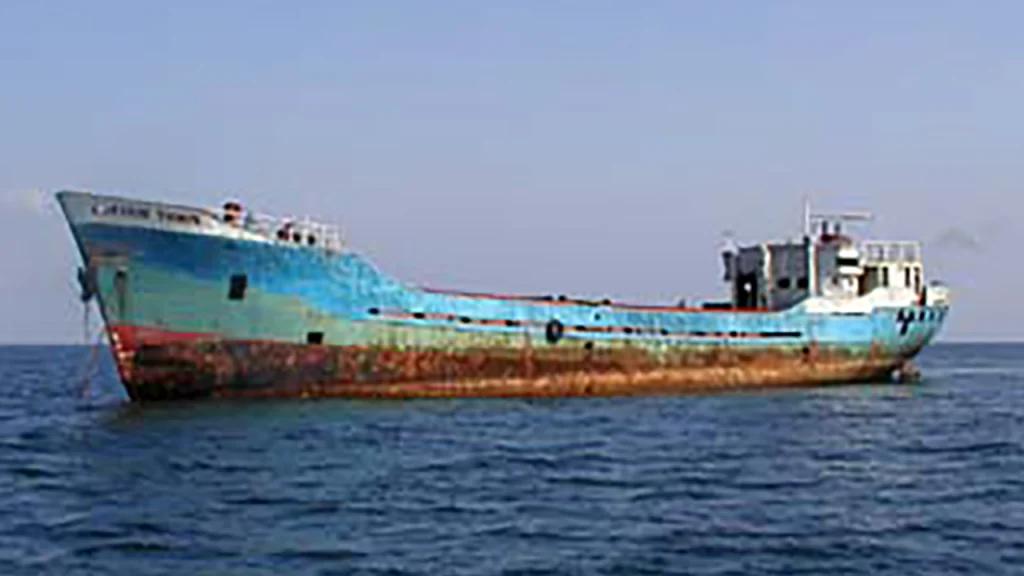Table of Contents

The combination of abundant marine life, especially during spawning season, the opportunity for shark encounters, and the unique multi-wreck drift dive experience makes the Zion Train a standout destination for divers visiting Florida’s southeast coast.
Article at a Glance
- Modern Artificial Reef: The Zion Train, a 164-foot freighter, was intentionally sunk in June 2003 to create an artificial reef off the coast of Jupiter, Florida.
- Hurricane Damage: The wreck suffered significant damage from Hurricanes Frances and Jean in 2004, leading to its current broken state, with the largest visible remnant being the stern section.
- Diving Depth: The wreck lies in approximately 90 feet (27.4 meters) of water, making it accessible for experienced divers.
- Part of Jupiter Wreck Trek: The Zion Train is part of the popular Jupiter Wreck Trek, which also includes other wrecks like the Esso Bonaire and Miss Jenny, offering divers multiple sites in one trip.
- Marine Life Hotspot: The wreck is renowned for attracting large aggregations of marine life, particularly Goliath groupers, which gather during their spawning season from mid-August to September.
- Shark Encounters: Divers can also expect to see lemon sharks and various schools of fish, including jacks and spadefish, enhancing the underwater experience.
- Ideal Diving Conditions: The best time to dive the Zion Train is during the Goliath grouper spawning season, when divers can witness these magnificent fish congregating in large numbers.
Shipwreck Location Coordinates and Depth
Depth
It sits in approximately 90 feet (27.4 meters) of water.
Location Coordinates
The wreck is well-known to local dive operators in the Jupiter area. Divers interested in visiting the site would need to book a trip with one of these local dive shops, who would have the precise coordinates for navigation purposes.

What Do Scuba Divers Say About This Ship
Popular Dive Site
The Zion Train is considered one of Jupiter’s top dive sites and a favorite among many divers3. It’s part of the Jupiter Wreck Trek, which is a popular drift dive featuring multiple wrecks.
Wreck Condition
Divers note that the Zion Train has been significantly damaged over the years:
- Originally scuttled in June 2003 as a 164-foot-long freighter.
- Severely damaged by Hurricanes Frances and Jean in 2004.
- Now broken apart, with the largest visible piece being the stern section.
- Some hull remains can be seen off to one side.
Marine Life Attraction
The main appeal for divers is not the wreck’s structure, but its ability to attract marine life:
- Known for large aggregations of Goliath groupers, especially during spawning season (mid-August through September).
- Attracts lemon sharks, which are frequently seen by divers.
- Home to schools of jacks, spadefish, and other fish species.
Diving Conditions
Divers report varying conditions:
- Depth is approximately 90 feet (27.4 meters).
- Visibility can range from 40-50 feet on good days.
- Currents are typically present, making it a drift dive.
Part of a Larger Dive Experience
The Zion Train is often dived as part of the Jupiter Wreck Trek, which includes:
- Zion Train (first in the drift)
- Miss Jenny (a small hopper barge)
- Esso Bonaire (another freighter)
What Kind of Marine Life Can Be Found on The Ship
Goliath Groupers
The most notable marine life attraction at the Zion Train wreck is the large aggregation of Goliath groupers:
- From mid-August through September, the wreck serves as a key spawning aggregation site for Goliath groupers.
- Divers can encounter gatherings of 40 to 60 Goliath groupers during a single dive.
- These gentle giants can grow up to 8 feet long and weigh up to 500 pound.
Sharks
The Jupiter Wreck Trek, which includes the Zion Train, is known for attracting various shark species:
- Lemon sharks are the most prevalent shark species encountered at the site.
Other Fish Species
The wreck also attracts a variety of other fish:
- Schools of jacks and spadefish are commonly seen passing by the wreck.
- Barracudas are sometimes present, especially when smaller bait fish are abundant.
Seasonal Visitors
During the Goliath grouper spawning season, the wreck attracts additional marine life:
- Small bait fish called scad arrive in large schools to feed on the eggs released by the groupers.
- These bait fish, in turn, attract predators like jacks and barracudas.
Key Information
| Aspect | Details |
|---|---|
| Location | Off the coast of Jupiter, Florida |
| Depth | 90 feet (27.4 meters) |
| Original size | 164-foot-long freighter |
| Date sunk | June 2003 |
| Purpose | Artificial reef |
| Current condition | Broken apart due to hurricanes Frances and Jean in 2004 |
| Largest visible piece | Stern section |
| Part of | Jupiter Wreck Trek |
| Other wrecks nearby | Esso Bonaire (freighter), Miss Jenny (small hopper barge) |
| Main attractions | Goliath grouper spawning aggregations (mid-August to September) |
| Lemon sharks | |
| Schools of jacks and spadefish | |
| Best time to visit | August-September for Goliath grouper aggregations |
| Number of Goliath groupers | 40 to 60 during spawning season |
| Diving experience | Drift dive |
What Makes The Zion Train Shipwreck a Unique Diving Experience
Marine Life Aggregations
The wreck’s most distinctive feature is its ability to attract large aggregations of marine life:
- During spawning season (mid-August through September), it becomes a key aggregation site for Goliath groupers.
- Divers can encounter gatherings of 40 to 60 Goliath groupers in a single dive.
- These massive fish can grow up to 8 feet long and weigh up to 500 pounds.
Shark Encounters
The Jupiter Wreck Trek, which includes the Zion Train, is known for its shark population:
- Lemon sharks are frequently seen around the wreck, making it a popular spot for shark enthusiasts.
Part of a Larger Dive Experience
The Zion Train is part of the Jupiter Wreck Trek, which includes:
- Zion Train (first in the drift)
- Miss Jenny (a small hopper barge)
- Esso Bonaire (another freighter)
This allows divers to experience multiple wrecks in a single drift dive.
Unique Wreck Structure
While the wreck itself has been damaged by hurricanes, its current state offers an interesting dive:
- Originally a 164-foot-long freighter, it’s now broken apart.
- The largest visible piece is the stern section.
- Some hull remains can be seen off to one side.
Diving Conditions
The site offers challenging but rewarding diving conditions:
- Located in about 90 feet (27.4 meters) of water.
- Often subject to currents, making it a drift dive.
- Visibility can vary, adding to the adventure.
How Does The Zion Train Compare to Other Shipwrecks in Florida
Age and Origin
Unlike many of Florida’s famous shipwrecks that date back to the colonial era or early 20th century, the Zion Train is a relatively modern wreck:
- It was intentionally sunk in 2003 as part of an artificial reef project.
- Many other notable Florida wrecks are from Spanish treasure fleets or World War II era ships.
Purpose
The Zion Train was deliberately sunk to create an artificial reef:
- It was not a casualty of war, piracy, or natural disasters like hurricanes.
- Many historic Florida wrecks were unintentional, often due to storms or warfare.
Accessibility
The Zion Train is easily accessible to recreational divers:
- Located in about 90 feet of water off Jupiter, Florida.
- Many historic wrecks are in deeper waters or protected areas with limited access.
Marine Life Focus
While historic wrecks may have archaeological significance, the Zion Train is valued primarily for its marine life:
- Known for large aggregations of Goliath groupers and shark encounters.
- Part of a planned dive experience (Jupiter Wreck Trek) rather than an isolated historical site.
Preservation State
Unlike some well-preserved historic wrecks, the Zion Train has been significantly altered:
- Damaged by hurricanes Frances and Jean in 2004, breaking it apart.
- Many older wrecks, especially in deeper waters, maintain more of their original structure.
Historical Significance
The Zion Train lacks the historical importance of many Florida shipwrecks:
- It doesn’t offer insights into colonial trade, warfare, or early American history.
- Many Florida wrecks are time capsules of their eras, providing valuable archaeological data.
What is The Full History of This Ship
Origin and Purpose
The Zion Train was originally a 164-foot-long freighter. It was intentionally scuttled in June 2003 as part of an artificial reef project off the coast of Jupiter, Florida.
Location
The wreck is located in approximately 90 feet (27.4 meters) of water off the coast of Jupiter, Florida. It’s part of a larger artificial reef system known as the Jupiter Wreck Trek.
Damage and Current State
Shortly after being sunk, the Zion Train was significantly damaged by hurricanes:
- In 2004, Hurricanes Frances and Jean hit Florida, causing severe damage to the wreck.
- The ship broke apart, as many freighters do when confronted by strong storm surges.
- Currently, the largest visible piece is the freighter’s stern section.
- Some remains of the hull can be seen off to one side.
Part of a Larger Dive Site
The Zion Train is now part of a popular dive site called the Jupiter Wreck Trek, which includes:
- Zion Train (the first wreck divers encounter)
- Miss Jenny (a small hopper barge)
- Esso Bonaire (another freighter, sunk in the 1980s)
Marine Life Attraction
While the wreck itself has been significantly altered, it has become known for attracting diverse marine life:
- It’s a key aggregation site for Goliath grouper spawning from mid-August through September.
- Divers can encounter gatherings of 40 to 60 Goliath groupers during a single dive in spawning season.
- The site also attracts lemon sharks, schools of jacks, and spadefish.

What Historical Features Can Still Be Identified on the Zion Train Wreck
- The Zion Train was originally a 164-foot-long freighter that was intentionally sunk in June 2003 to create an artificial reef.
- The wreck was significantly damaged by Hurricanes Frances and Jean in 2004, which caused it to break apart.
- Currently, the largest visible piece of the wreck is the stern section. This is likely the most identifiable historical feature remaining.
- Some remains of the hull can be seen off to one side of the main wreck site.
- The wreck lies in approximately 90 feet (27.4 meters) of water.
Given the extensive damage from hurricanes and the relatively short time the ship was intact underwater (about 1 year), it’s likely that few distinct historical features remain easily identifiable. The stern section appears to be the most prominent remaining structure from the original ship.
It’s important to note that the Zion Train’s value as a dive site now stems more from its role as an artificial reef and its ability to attract marine life, particularly large aggregations of Goliath groupers during spawning season, rather than from any preserved historical features of the ship itself.
What Safety Measures Are in Place for Divers Visiting the Zion Train
Dive Planning and Preparation
- Divers should check current conditions, including visibility and currents, before diving.
- It’s advisable to dive with a local operator familiar with the site.
- Divers should ensure they have appropriate certifications for the depth (approximately 90 feet).
Buddy System
- Always dive with a buddy for increased safety.
- Maintain visual contact with your dive partner throughout the dive.
Equipment Checks
- Perform thorough pre-dive equipment checks.
- Ensure all gear is in good working condition and appropriate for the dive.
Awareness of Marine Life
- Be cautious around large marine life like Goliath groupers and sharks.
- Maintain a safe distance and avoid touching or disturbing wildlife.
Wreck Diving Precautions
- Avoid penetrating the wreck unless properly trained and equipped.
- Be aware of potential sharp edges or unstable structures on the damaged wreck.
Current Considerations
- The site is known for currents, so divers should be prepared for drift diving techniques.
- Use a surface marker buoy (SMB) for increased visibility to boats.
Decompression Awareness
- Plan dives within no-decompression limits.
- Make safety stops as appropriate for the depth and duration of the dive.
Emergency Procedures
- Be familiar with emergency procedures and the location of the nearest decompression chamber.
- Carry appropriate safety equipment such as dive computers and signaling devices.
Dive Shops That Provide Diving Trips to This Shipwreck
- upiter Scuba Diving
- Address: 1111 Love St, Jupiter, FL 33477
- Phone: (855) 575-3483
- Website: https://jupiterscubadiving.com
- Salty Divers
- Address: 800 US-1, Jupiter, FL 33477
- Phone: (561) 247-1119
- Website: http://saltydivers.com
- Florida Shark Diving
- Address: 1095 N Hwy A1A, Jupiter, FL 33477
- Phone: (305) 395-9140
- Website: https://floridasharkdiving.com
South Florida Wrecks
- SS Copenhagen
- Captain Dan Wreck
- SS Arratoon
- Queen of Nassau
- USS Mohawk
- MV Castor
- Esso Bonaire III
- St. Jacques
- The Gilbert Sea
- Shasha Boekanier
- Thozina
- The Orion
- The DEMA Trader
- Ancient Mariner
- The Amaryllis
- The Ande
- USS Hydro Atlantic
- Zion Train
- Mercedes I
- Half Moon
- The Danny
- The Ultra Freeze
- The Doc DeMilly
- Jay Scutti
- The Tracy
- Sea Emperor
- Jim Atria
- Merci Jesus
- Princess Britney





